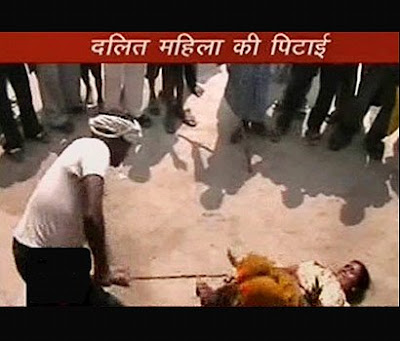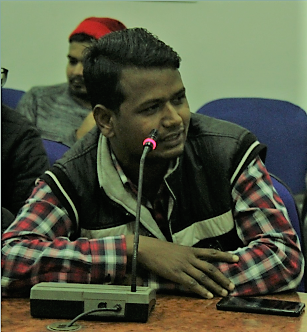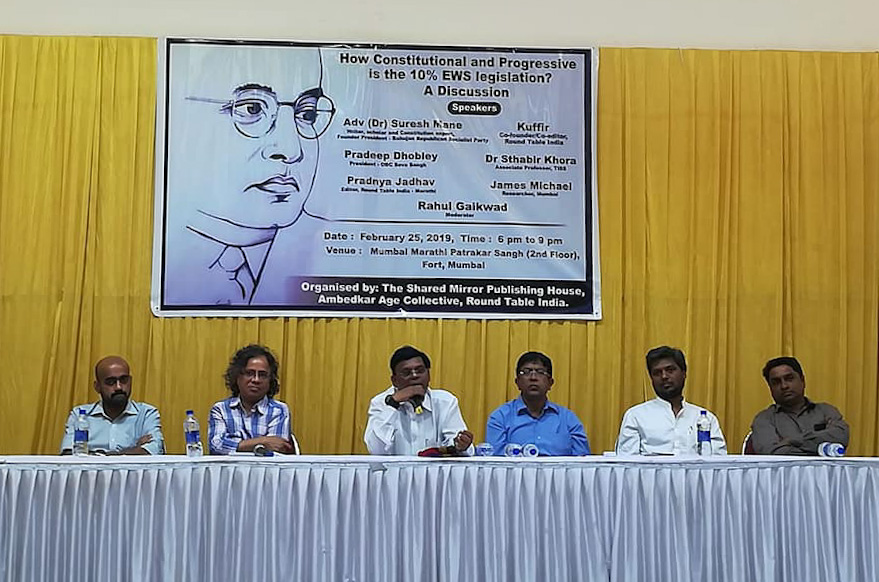Kuffir
It is a clear visual representation of ‘secular violence’, which has its roots in the presentation of the Indian National Congress and the Nationalist movement as an unproblematic social organization and process, through which India gained freedom for the betterment and advance of all its ‘citizens.’
– Savari, in ‘Whipping up ‘critical pedagogy’: Uncritical defense of NCERT’s violence‘.
~~~
He draws a mob as big as India, adds a panch-enforcer with a whip, points to the accused, and renders mob justice.
Indian children understand mob justice quite well. They see it on the street, on television, in newspapers; its appearance now in text books, thanks to this cartoon, will take the process of normalizing it a little further. Think of thieves being beaten up. Thieves being tied and beaten up. Many of them minors. ‘Bad’ women being beaten up. Women practising ‘witchcraft’ being beaten up. Dalit women being beaten up. The children also see, hear and read about khaps.
 [Interspersed through this article are pictures of actual public scenes involving mobs inflicting violence on individuals. Hope they arouse some critical thinking]
[Interspersed through this article are pictures of actual public scenes involving mobs inflicting violence on individuals. Hope they arouse some critical thinking]
Why did a substantial section of the brahminzed classes not see it that way? They didn’t/don’t see even Hazare, another whip wielder, that way. The Indian public sphere is still very unproblematic.
Some say Nehru was whipping the snail, not Dr Ambedkar. So what was Dr Ambedkar doing in the picture? Like the Indian mob usually does, Shankar wanted an identifiable two legged villain.
The joke is that the cartoon renders the whole purpose of the constitution making process meaningless: wasn’t the constitution meant to do away with mob justice and other such undemocratic practices? What is the lesson the kids get out of it? Democracy? That is the joke.
~~~
 The whole scene depicted in the cartoon reflects the atmosphere of a trial. Even if the whips were absent, or replaced by raised hands or something else representing punitive motives, the atmosphere wouldn’t change much. Even if the snail was absent, or replaced by something else indicating the sin or crime of sloth, the trial would go on.
The whole scene depicted in the cartoon reflects the atmosphere of a trial. Even if the whips were absent, or replaced by raised hands or something else representing punitive motives, the atmosphere wouldn’t change much. Even if the snail was absent, or replaced by something else indicating the sin or crime of sloth, the trial would go on.
It implicitly depicts a headman like figure questioning or appraising or chastising, depending on how critical your views on violence are, another man’s performance, on behalf of a collective, as in a khap. And that’s exactly why the cartoon is objectionable, not only because it seems to be portraying a Brahmin whipping a Dalit. It is objectionable because it portrays a typical, communal Indian majority exercising arbitrary power over an individual.
It reeks of arbitrariness, violence and majoritarianism. Definitely not values you want kids to imbibe or memes that would trigger critical thinking.
But Dr Ambedkar is also holding a whip, they say. True, so should we hold Babasaheb responsible for Shankar thrusting a whip into his hand? Shankar’s imagination runs along predictable lines: he believes a man-beats-down-man world is very normal, obviously.
Doesn’t the cartoon look like a graphic representation of the principle of ‘graded inequality’? Everyone gets a whip and beats up the person below him in the hierarchy.
~~~
 Everyone’s holding a whip except for the snail. You could say that Dr Ambedkar would rather have given the power to wield the whip to the snail, or the constitution, and not to the panch-enforcer or the mob acquiescing to his actions. His purpose was directly opposed to Shankar’s conservative scheme which, as depicted in the cartoon, holds all the elements of the grammar of varna-archy.
Everyone’s holding a whip except for the snail. You could say that Dr Ambedkar would rather have given the power to wield the whip to the snail, or the constitution, and not to the panch-enforcer or the mob acquiescing to his actions. His purpose was directly opposed to Shankar’s conservative scheme which, as depicted in the cartoon, holds all the elements of the grammar of varna-archy.
Whips, carts, mobs, and topi wearing panches: all evoke a rural environment, so idealized by Gandhians for its supposed simplicity. Ambedkar would have seen it as exuding a miasma of ‘localism, ignorance, narrow-mindedness, and communalism’.
The joke is that the only modern, egalitarian element in the scene, the ‘constitution’, is shown as being inefficient even before it’s born.
They say the snail is a clever device to explain the inherent slowness of any constitution making process. That’s inferred justification, clearly.
Not even the members of the constituent assembly of the time understood fully the reasons for the delay, nor did they all exhibit any great awareness that all constitution making processes are inherently slow. So Dr Ambedkar himself had to explain the reasons, in painstaking detail, and also offer insights on why and how constitutions of other democracies were delayed or drafted faster.
Could Shankar have had a better understanding of the constitution making processes than the very bright parliamentarians of the time? Moreover, Shankar’s cartoon was published in August, 1949. Dr Ambedkar delivered his explanation on the delay, on the floor of the constituent assembly, in the third week of November, 1949. Shankar could only have been more concerned about the delay.
 Whether Shankar was aware that all constitutions, inherently, were slow cannot be determined with any certainty. But we know that he knew that the Indian constitution making process was slow because that’s what his cartoon obviously wanted to point out, and he somehow, consciously or otherwise, associated the delay with the leader of the team, Dr Ambedkar, whom he held accountable. Dr Ambedkar is accountable for the delay, in Shankar’s view, because he also holds a whip, you see.
Whether Shankar was aware that all constitutions, inherently, were slow cannot be determined with any certainty. But we know that he knew that the Indian constitution making process was slow because that’s what his cartoon obviously wanted to point out, and he somehow, consciously or otherwise, associated the delay with the leader of the team, Dr Ambedkar, whom he held accountable. Dr Ambedkar is accountable for the delay, in Shankar’s view, because he also holds a whip, you see.
So much for the caste-neutral whip.
~~~
The joke is that the whip in Dr Ambedkar’s hand is generally being flaunted as proof that the cartoon complies with some unwritten, but commonly understood, equal opportunity norms (as seen from a savarna perspective), as evidence of savarna generosity. Much broader inferences are also being drawn: of savarna (as represented through Shankar) fairness, generally, and the willingness to share power equally. In truth, it only confirms the tendency of the brahminized classes to apportion blame unequally.
They say the text accompanying the cartoon explains the delay in the drafting of the constitution. Does Shankar’s cartoon explain the delay? Does it carry any text that explains the delay?
 The cartoon by itself apportions blame unequally. It calls the snail ‘constitution’, not ‘constituent assembly’. The constitution couldn’t have made itself even if prodded or whipped. Why was Nehru, if that’s what he was doing, whipping the ‘constitution’?
The cartoon by itself apportions blame unequally. It calls the snail ‘constitution’, not ‘constituent assembly’. The constitution couldn’t have made itself even if prodded or whipped. Why was Nehru, if that’s what he was doing, whipping the ‘constitution’?
Among the two, only Dr Ambedkar could be accused of having agency, not the ‘constitution’, and hence Shankar’s whip, or blame, was intended for him.
The text accompanying the cartoon in the text book, they say, brings in other characters, responsible for the delay, into the picture. The cartoon doesn’t have any other characters, or culprits.
Text plus cartoons. Plus text to explain cartoons. Plus cartoons to explain that explanatory text? Critical pedagogy, as promoted by savarna intellectuals, seems like a voluminous joke that’s bound to break many children’s backs.
~~~
 For those who find nothing objectionable about it, the cartoon works because they share the presumption that the course had already been charted and the constitution maker had to only follow the path laid down, like an engine driver taking a train down preset tracks. His job required no thinking or any exercise of imagination on his part– the task had already been agreed upon, the design or the blueprint was common knowledge among the people (read: the new savarna legatees of the empire). That’s why the display of impatience, as signified by the whip, by Nehru, at the lethargy shown by those who only had to pay heed to commonly understood rules.
For those who find nothing objectionable about it, the cartoon works because they share the presumption that the course had already been charted and the constitution maker had to only follow the path laid down, like an engine driver taking a train down preset tracks. His job required no thinking or any exercise of imagination on his part– the task had already been agreed upon, the design or the blueprint was common knowledge among the people (read: the new savarna legatees of the empire). That’s why the display of impatience, as signified by the whip, by Nehru, at the lethargy shown by those who only had to pay heed to commonly understood rules.
But Dr Ambedkar understood that there was no commonly understood design, not since this land was born, and that there could be no nation without such a design. This old newspaper story from 1946, dug up by a friend, tells you how acutely aware Dr Ambedkar was of the need for a design.

The irony is: Nehru, who was dreaming up vote-catching schemes to capture the new state when Ambedkar was working precociously to conceptualize a nation, is presented as the default nation-builder in the cartoon while the latter is painted as a kind of obstructionist.
Did Shankar ever draw a cartoon which shows Nehru and others bowing down and paying salaams to Dr Ambedkar for taking them through the magnificent enterprise of conceiving a nation, modern and democratic at that, or something similar which expressed gratitude, at least?
Do you see any awe in Shankar’s perception of what Dr Ambedkar was doing?
The joke is that he fell asleep at the switch. He went to a revolution and all that he brought back was a lousy T-shirt. He missed his tryst with destiny.
He didn’t draw jokes, he was one.

Pictures Courtesy: the internet.










